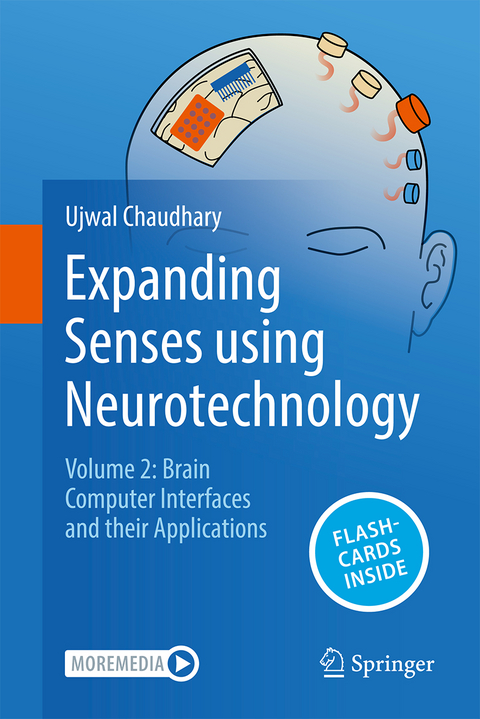
Expanding Senses using Neurotechnology
Springer International Publishing (Verlag)
978-3-031-78990-8 (ISBN)
- Noch nicht erschienen - erscheint am 21.02.2025
- Versandkostenfrei
- Auch auf Rechnung
- Artikel merken
This book provides a comprehensive exploration of the transformative field of brain-computer interfaces (BCIs) and neurotechnology. As the fusion of neuroscience, engineering, and artificial intelligence advances, this textbook guides readers through foundational principles and recent innovations that are reshaping how we understand and enhance brain-body abilities.
From non-invasive BCIs and their role in communication and motor restoration to invasive BCIs designed for individuals with locked-in syndrome and beyond, each chapter delves into cutting-edge applications, including neurofeedback therapy and treatments for neuropsychiatric conditions like ADHD and depression. Additionally, the textbook addresses the crucial ethical, legal, and societal implications, exploring concerns over mental privacy, informed consent, and the commercialization of brain data.
Intended for students, researchers, and professionals in neuroscience, biomedical engineering, and related fields, this text serves as both a technical guide and an ethical roadmap to the profound future of neurotechnology.
This book contains more than 110 questions and answers: Download the Springer Nature Flashcards App free of charge and use exclusive additional material to test your knowledge.
Ujwal Chaudhary, Ph.D. Dr. Chaudhary studied Bachelor of Technology in Biomedical Engineering; he was awarded the gold medal for scoring the highest rank. He graduated with Ph.D. in Biomedical Engineering from the Biomedical Engineering department at Florida International University, Miami, USA in 2013. He was awarded the “Outstanding doctoral degree graduate award” for his doctoral dissertation. After his graduation, he worked as a postdoctoral researcher/group leader at the University of Tubingen. He has been working towards the development of several kinds of brain-computer interface (BCI) namely, intracortical BCI (iBCI), electroencephalogram (EEG) /Electrooculogram (EOG), functional near-infrared spectroscopy (fNIRS), and transcranial direct current stimulation (tDCS) based BCIs to investigate and provide a means of communication to patients in locked-in state (LIS) and completely locked-in state (CLIS). He pushed the limit of BCIs; for the first time in history, the team enabled complete sentence formation by someone in CLIS using an iBCI.
Chapter 1. What is Brain Computer Interface (BCI)?: Fundamental Principles of BCI.- Chapter 2. Neurotechnology in Stroke Rehabilitation: Innovations in Stroke Recovery and Neurotechnology.- Chapter 3. Neurotechnology for Spinal Cord Injury Rehabilitation: Harnessing Neurotechnology and Multidisciplinary Strategies.- Chapter 4. Non-Invasive BCI for Communication: SCP, SMR, P300 and SSVEP.- Chapter 5. Invasive BCI for Communication: Advanced BCI Solutions for Restoring Communication.- Chapter 6. BCI for ADHD, ASD, and MCI: Neurobiological Insights and Therapeutic Advances.- Chapter 7. Neurotechnologies in Anxiety and Depression: Advances in Treatment and Personalized Care.- Chapter 8. Neurotechnology for Disorders of Consciousness.- Chapter 9. Neuroethics for Neurotechnology.- Chapter 10. Expanding Human Capabilities with Neurotechnology: Neuroprosthetics, BCIs, and Emerging Innovations.
| Erscheint lt. Verlag | 21.2.2025 |
|---|---|
| Zusatzinfo | X, 460 p. 130 illus., 120 illus. in color. |
| Verlagsort | Cham |
| Sprache | englisch |
| Maße | 155 x 235 mm |
| Themenwelt | Mathematik / Informatik ► Informatik ► Theorie / Studium |
| Medizin / Pharmazie ► Physiotherapie / Ergotherapie ► Orthopädie | |
| Medizin / Pharmazie ► Studium | |
| Naturwissenschaften ► Biologie ► Humanbiologie | |
| Naturwissenschaften ► Biologie ► Zoologie | |
| Technik ► Medizintechnik | |
| Schlagworte | AI Models • brain computer interface • brain imaging • Brain Signal • feature extraction • Invasive Brain Imaging • machine learning • Neurofeedback • Neuromodulation • Neuroprosthetics • Neurotechnology • Non-invasive brain imaging |
| ISBN-10 | 3-031-78990-3 / 3031789903 |
| ISBN-13 | 978-3-031-78990-8 / 9783031789908 |
| Zustand | Neuware |
| Informationen gemäß Produktsicherheitsverordnung (GPSR) | |
| Haben Sie eine Frage zum Produkt? |
aus dem Bereich


